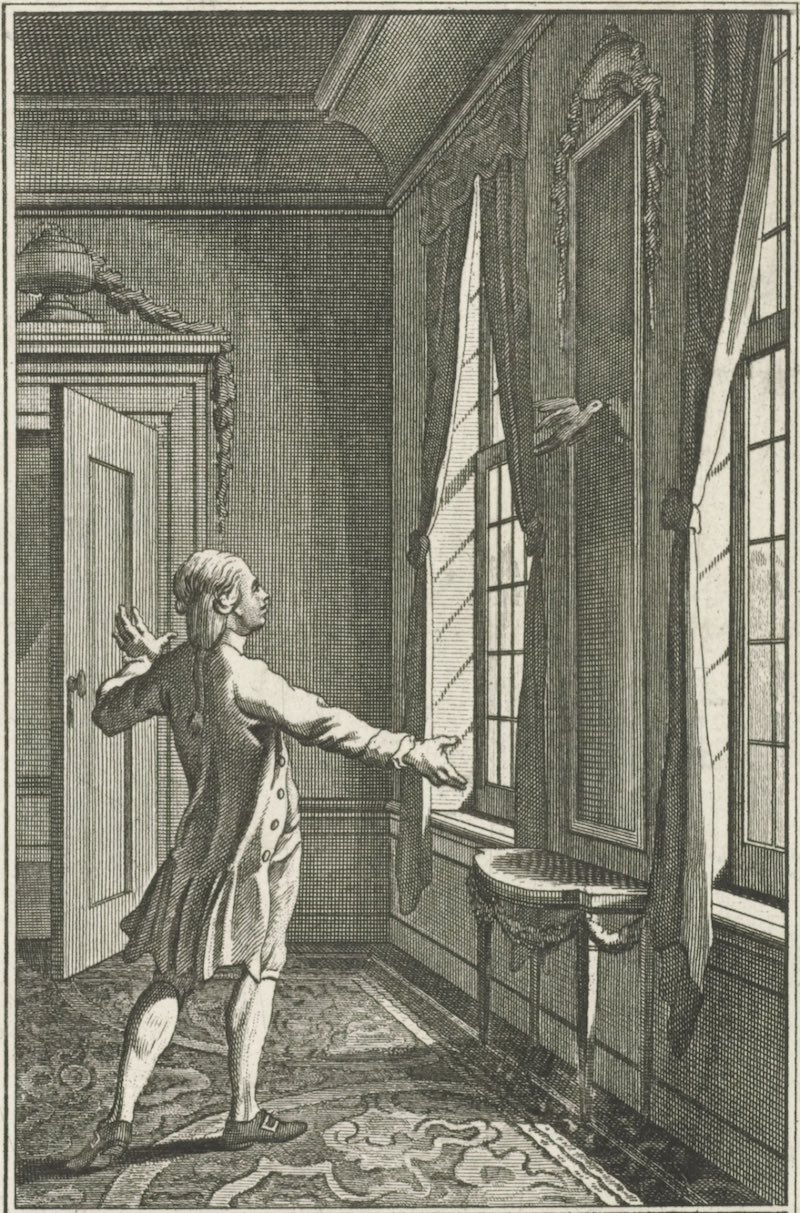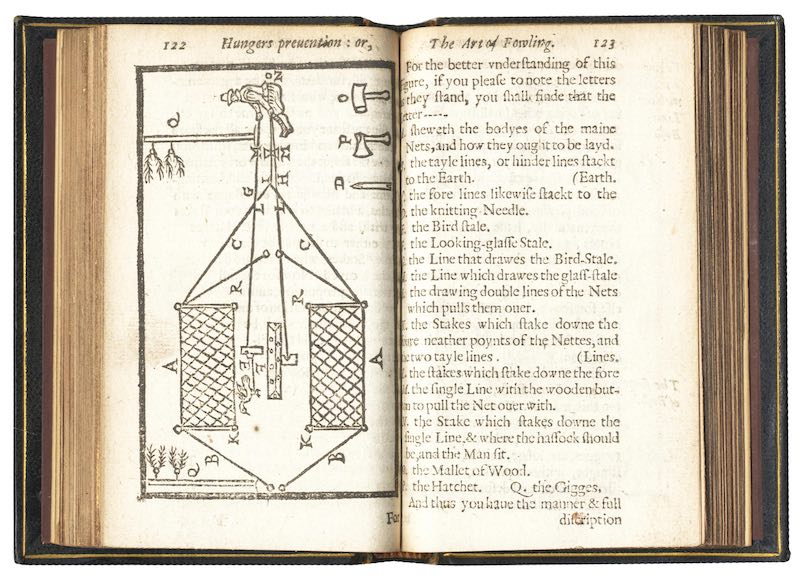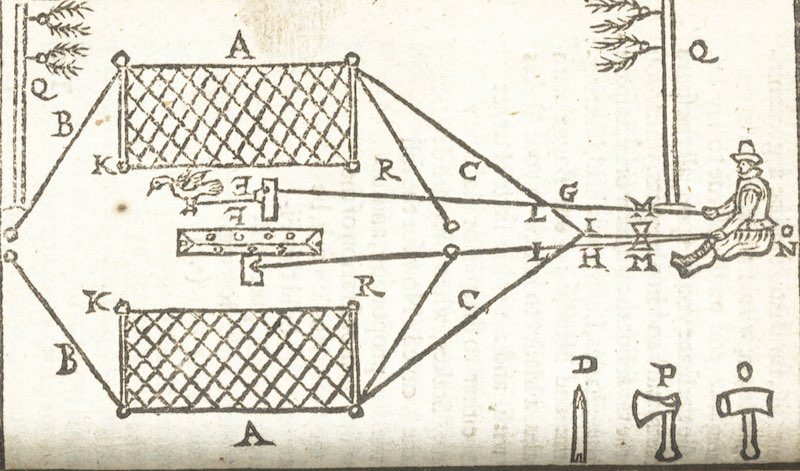Lark Mirrors
How do you catch a lark? Hester Pulter knew. Given the popularity of larks in seventeenth-century British cuisine, she may often have witnessed these birds being lured, captured, and killed in the meadows surrounding her country estate of Broadfield (and then served at her table). Only twenty-five miles away lay the town of Dunstable, “the most renowned place for lark catching” in England (Fenech, p. 43).
The preferred early modern technique for lark-hunting, to which Pulter alludes more than once, involved mirrors: a technology of special interest, perhaps, to so self-reflective a poet. In “The Cruel Tiger”, “the early rising lark” is—in her role as an emblem of pride—“ensnared with looking in a glass” (lines 5-6). This glass, a looking-glass, was likely an example of a lark mirror, a specialized piece of technology, although the following eighteenth-century illustration suggests that larks could also be ensnared by the ordinary kind of mirror (just as songbirds today are, by the millions, fatally attracted to windows):

Noach van der Meer (II), naar Jacobus Buys, Leeuwerik en de spiegel, 1777. Rijksmuseum. Public Domain.
But what was a lark mirror? Pulter’s The Lark46 opens with an accidental simulacrum of the weapon in question:
- See how Arachne doth her hours pass
- In weaving tinsel on the verdant grass:
- Look how it glitters now the sun doth rise,
- The bane of harmless sheep and death of flies,
- And over it, the slow and unctuous snail
- In winding knots doth draw a slimy trail.
- The cheerful lark, as in the air she flies
- And on this gossamer casts down her eyes,
- Takes it for mirrors laid by rural swains
- And therefore fears to light upon the plains.
Unlike the more typically emblematic bird in “The Cruel Tiger,” this particular lark is too savvy to be taken in by shiny things or her own vanity. In her edition of Pulter’s poems, Alice Eardley glosses the “mirrors laid by rural swains” here by explaining that looking glasses were, at this time, used to ensnare larks: “Small fragments [of mirror] would be stuck to a piece of wood and the device would be hung up in a way that allowed it to turn about. Birds would be attracted to the motion of the light reflected off the mirrors and then caught” (p. 154).
Gervase Markham, in Hunger’s Prevention: Or, The Whole Art of Fowling by Water and Land (London, 1621; 1655), includes highly detailed technical instructions for the lark mirror as part of a contraption called a “day net.” The net itself was made from packthread or “housewife’s thread,” a term which suggests that this sort of net could be among the many textiles gendered female in early modern England. Such a snare served to trap not only larks but “buntings, merlins, hobbies, or any bird that playeth in the air.” It had first to be spread and staked over level meadows, so that, sinking into the grass or stubble, it “may lie as it were hidden and unperceived by the birds which shall play over the same.” The fowler then would walk a distance away in order to set out his “gigs, or playing wantons.” These were “toys made of long goose feathers” fastened atop poles, where they would “play and make a noise” in the wind, “twirl[ing] and flicker[ing] in the air after such a wanton manner, that the birds will come in great flocks to wonder and play about the same.” Next the fowler had to introduce a “stale” or “inticement”: a small wooden stake with a long cross-bar flexibly attached, as well as a long line to which one attached a live lark. By twitching the string, the tormented bird was made, Markham writes, to “flicker up and down,” attracting other, not-yet-captive birds “to play about it,” until they would swoop low enough to be netted (pp. 111-16).
As well as the “inticement” of the live bird, lark hunters deployed mirrors. In this case, the “stale” was hollowed at the top, so that another piece might be fitted inside. When a thread tied to the fitted piece was pulled, it would twirl about “in such sort as you shall see children and schoolboys do with whirligigs.” To the fitted piece would be glued “twenty small pieces of looking-glasses,” whose “continual motion and turning about … will give such a glorious reflection that the wanton birds cannot forbear but will play about it with admiration, till they be taken” (p. 118).
Markham’s illustration helps to clarify the lark hunter’s gear:

Gervase Markham, Hunger’s Prevention: Or, the Whole Art of Fowling by Water and Land. Containing All the Secrets Belonging to That Art, and Brought into a True Form or Method, by Which the Most Ignorant May Know How to Take Any Kind of Fowl, Either by Land or Water (London, 1621), pp. 122-3. Bonhams.
In the opening above, Markham’s alphabetical key indicates that the mirrored stale is the item labeled “F” (which is backward-facing in the illustration below):

Gervase Markham, Hunger’s Prevention: Or, the Whole Art of Fowling by Water and Land. Containing All the Secrets Belonging to That Art, and Brought into a True Form or Method, by Which the Most Ignorant May Know How to Take Any Kind of Fowl, Either by Land or WaterWater (London, 1621), p. 122. Bonhams.
As the passages quoted above show, Markham’s description of the lark trap frequently invokes forms of free and freely desiring behaviour, both in the “wanton birds” which “wonder and play” with “admiration,” and in the traps composed of “toys,” “inticement[s],” and “playing wantons,” all moving in “a wanton manner.” And Markham was not alone in regarding the device in this light: another contemporary account of the lark mirror indicates that it “will turn so round that it will give a strange reflection, and so continuing the turning, it will entice the birds to play wonderfully” (“A Treatise of Fowling,” A Jewel for Gentry [London, 1614], sig. K1r-v). John Bunyan went further, offering some blunt spiritual exegesis of his own poetic lark-mirror: “the glass an emblem is of sinful pleasure” (see below). The association of such death-dealing traps with strange, pleasurable, and moving desires suggests a cultural discourse in which freedom, desire, and pleasure are implicated in danger, or even doom: as for Eve and Adam, so for buntings and larks. And in all cases, as in Pulter’s “The Cruel Tiger,” pride goes before a fall.
Pulter was not the only poet of her generation to reflect on the fascinating power of the lark mirror. John Bunyan, in A Book for Boys and Girls, or, Country Rhymes for Children, wrote an emblematic piece featuring the kind of snare described by Markham, followed by an explication of the scene’s spiritual allegory (in “Comparison”):
Upon the Lark and the Fowler
- Thou simple bird, what mak’st thou here to play?
- Look, there’s the fowler: prithee, come away.
- Dost not behold the net? Look there: ’tis spread;
- Venture a little further, thou art dead.
- Is there not room enough in all the field
- For thee to play in, but thou needs must yield
- To the deceitful glitt’ring of a glass,
- Placed betwixt nets to bring thy death to pass?
- Bird, if thou art so much for dazzling light,
- Look, there’s the Sun above thee: dart upright!
- Thy nature is to soar up to the sky,
- Why wilt thou come down to the nets, and die?
- Take no heed to the fowler’s tempting call;
- This whistle he enchanteth birds withal.
- Or if thou seest a live bird in his net,
- Believe she’s there ’cause thence she cannot get.
- Look how he tempteth thee with his decoy,
- That he may rob thee of thy life, thy joy:
- Come, prithee bird, I prithee come away;
- Why should this net thee take, when ’scape thou may?
- Hadst thou not wings, or were thy feathers pulled,
- Or wast thou blind, or fast asleep wer’t lulled:
- The case would somewhat alter; but for thee,
- Thy eyes are ope, and thou hast wings to flee.
- Remember that thy song is in thy rise,
- Not in thy Fall; Earth’s not thy paradise.
- Keep up aloft then, let thy circuits be
- Above, where birds from fowlers nets are free.
- This fowler is an emblem of the devil,
- His nets and whistle, figures of all evil.
- His glass an emblem is of sinful pleasure,
- And his decoy, of who counts sin a treasure
- This simple lark’s a shadow of a saint,
- Under allurings, ready now to faint.
- This admonisher a true teacher is,
- Whose work’s to shew the soul the snare and bliss.
- And how it may this fowler’s net escape,
- And not commit upon itself this rape.
Somewhat inconsistently, Bunyan allegorizes his own poems as ensnaring lark-mirrors for both children and their parents, whom he castigates, in the prefatory address to the volume, for their arrested development. He indicates that he aims, with his poems, to catch their “fancies”:
To the Courteous Reader
- … good reader, that I save them may,
- I now with them the very dotterel play.
- …
- And like a fool stand fing’ring of their toys;
- And all to shew them, they are girls and boys.
- Nor do I blush, although I think some may
- Call me a baby, ’cause I with them play:
- I do’t to shew them how each fingle-fangle,
- On which they doting are, their souls entangle,
- As with a web, a trap, a gin, or snare:
- And will destroy them, have they not a care.
- …
- … [B]y their play-things, I would them entice,
- To mount their thoughts from what are childish toys,
- To Heav’n, for that’s prepar’d for girls and boys.
- Nor do I so confine myself to these,
- As to shun graver things; I seek to please
- Those more compos’d with better things than toys:
- Though thus I would be catching girls and boys.
- Wherefore if men have now a mind to look;
- Perhaps their graver fancies may be took
- With what is here …
The “dotterel” Bunyan “play[s]” is, in fact, a songbird much like the lark: specifically, a kind of plover which is “so called,” the OED explains, “from the apparent simplicity with which it allows itself to be approached and taken” (since the second meaning of the word is “a silly person, … a dotard”—or a “fool,” the role Bunyan claims). Bunyan is thus like the live lark lure in Markham’s equipment, while his poems are the equivalent of the lark hunter’s spangly mirrors. As Margaret J. M. Ezell has shown, it was not at all unusual in early modernity to imagine texts as a mirrors (“Looking Glass Histories.” Journal of British Studies, vol. 43, no. 3, 2004, pp. 317–338). Bunyan does not overtly call his poems mirrors, but he does refer to them in terms of “play-things” and “toys” for “entic[ing]” readers, in diction reminiscent of Markham’s description of the lark mirror. Bunyan, however, aims to use his own poetic traps to entice his readers toward Heaven.
Might Pulter also have seen her emblems as alluring mirrors in this sense? Ezell notes that the high point for the troping of a printed text as a mirror—“as an enticement” (an echo of Markham!) “to readers to purchase and peruse its contents”—was the mid-seventeenth century (p. 316): precisely when Pulter was writing. Just as Bunyan hoped to capture the fancies or imaginations of readers with lark-mirror-like emblematic poems, Pulter may well have sought to create (and may also have found) a similar source of fascination in her own verse reflections. It is worth noting that the looking-glass snare depended, for its efficacy, on a dazzling array of circular movements, of twirling “wantons” and whirling mirrored pieces, the latter designed to turn so smoothly as to “keep the engine in a perpetual round motion” (Markham pp. 117-8). So much may have made these devices at least as attractive to Pulter as to songbirds, since her own lyric oeuvre generally evinces an almost obsessive attention to all manner of revolving, cyclic forms. See, for instance, Pulter’s four poems called “The Circle,” as well as three of Elizabeth Scott-Baumann’s Curations for The Circle [2]21: Circles and Labyrinths; Circles in Alchemy; and Devotional Circles.
Further Reading
- Natalino Fenech, “Lark Mirrors: From Tools to Folk Art,” Folk Life, vol. 44, no. 1, 2005, pp. 30-47. Taylor & Francis Online.